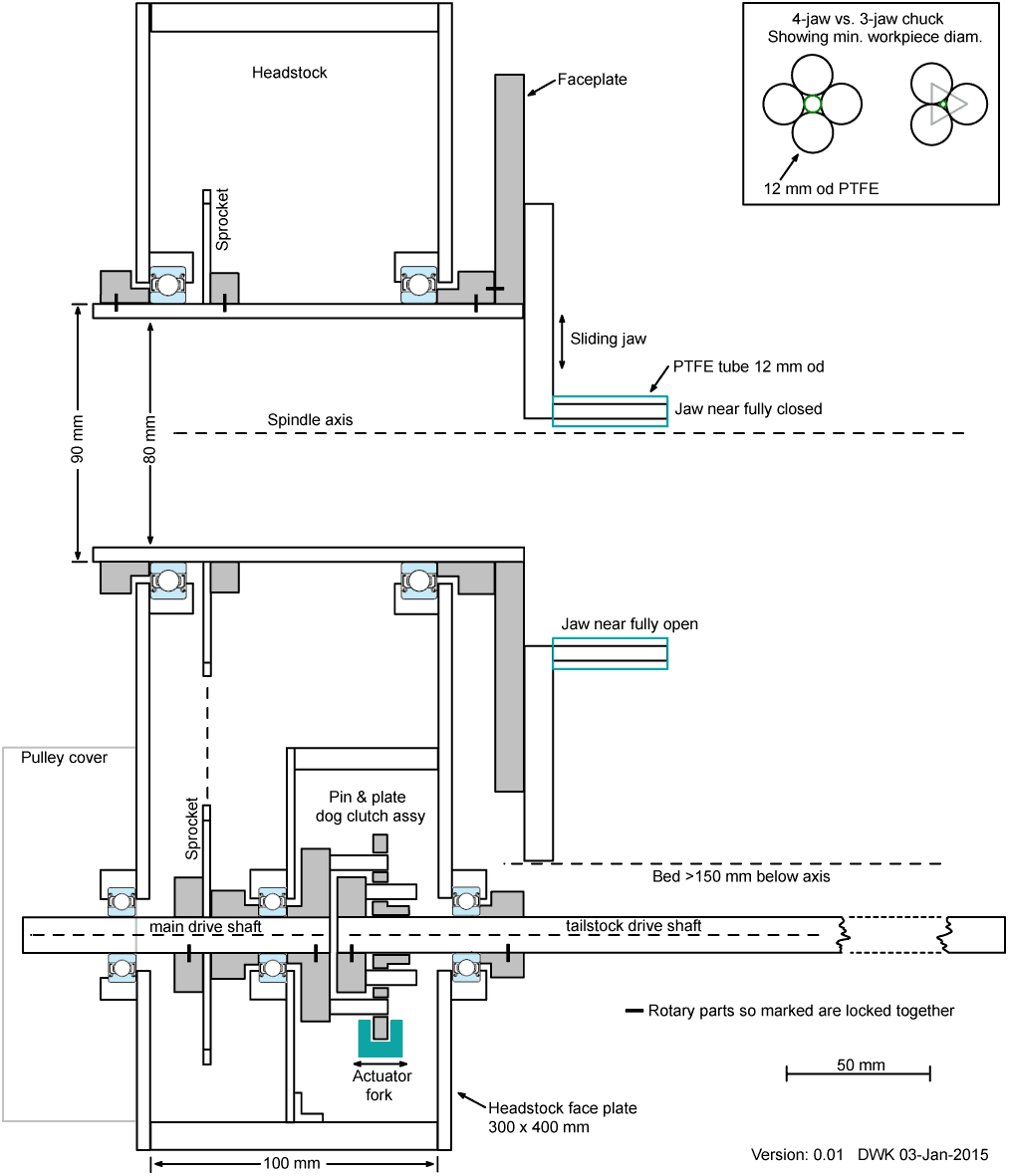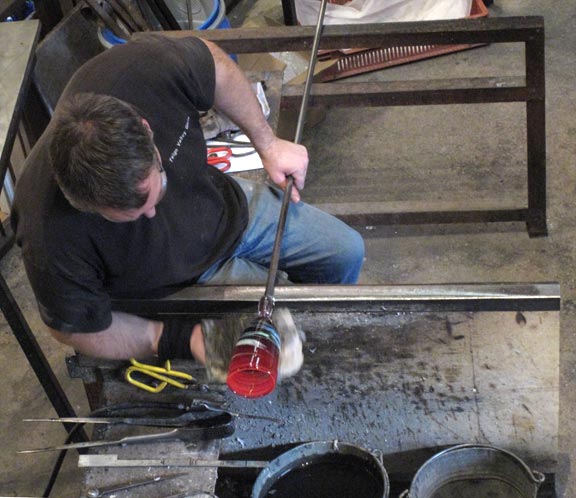| Workshop |
Glass lathe
I did a glass-working course in my final undergraduate year (1981-1982); and in the research lab where I did my final-year project there was a town-gas (mostly methane) and oxygen burner used for fixing-up vacuum lines, etc.. So, for practice, I took to raiding lab rubbish bins for broken Quickfit (ground-joint borosilicate) glassware; and during the long boring periods of waiting for spectroscopic scans to complete, I salvaged glassware parts and welded them together to make usable items. These were mostly things like separating funnels, still-heads and vacuum adapters. Hand annealing was the only option, and so some of it cracked where I had welded too close to cones, sockets and stopcocks; but a lot of it was fine, and I still have some perfectly serviceable pieces.
In 2013 to 2014, I became interested in vacuum systems again; this time for the purpose of using the ionisation of low-pressure gas to reveal the standing-wave patterns on helical transmission lines. That work was self-funded however, and I somehow seemed to have developed a powerful aversion to paying the prices that science equipment suppliers ask for vacuum-system components. The general solution, of course, would have been to revive the art of the glass vacuum line, which is cheap and cheerful, and has the advantage that it doesn't conduct electricity.
There is however more to making a vacuum line than welding bits of glass tubing together. It is a collection of components that includes traps, gauges, valves, stopcocks, ports and receiving chambers. Thus a certain manufacturing capability is required beyond the possession of an oxy-propane torch, and this led to an interest in glass lathes. Such machines are rare, fabulously expensive, and much sought-after; but they are not particularly complicated, and making one is not beyond the capabilities of a small workshop equipped with a lathe and a milling machine.
Various descriptions of home-built glass lathes can be found on the web, but most designs are based on the metal-working lathe. This is a workable but not necessarily ideal approach. About the only thing that a glass lathe has in common with a metal lathe is that the workpiece is rotated about a horizontal axis. After that, there is no great similarity. A glass lathe is an anti-gravity machine, allowing molten glass to be worked without sagging. Its typical rate of rotation is about 1 revolution per second. There is no need to apply any torque to the workpiece, which is held lightly in a soft-jawed chuck. Most versatility is obtained if large diameter tubes can pass through the chuck, which means a large spindle throat.
The basic operation performed by a glass lathe is that of joining co-axial tubes. This requires two chucks rotating in synchrony; one fixed horizontally (the headstock); and one moveable on a sliding bed, or on rails (the tailstock). Traditional designs have the chucks synchronised by means of belts and a drive shaft, with the ability to disengage the tailstock drive in the event that only one chuck is needed (see Edwards G3 diagrams below). Separate chucks driven by stepper motors is a more modern option that sidesteps a great deal of mechanical complexity.
Web links:


DWK's ideas on constructing a glass lathe while experimenting with various methods for visualising EM field patterns around solenoids(Jan 2015).

In 2014, I bought an Edwards 2-stage rotary vacuum pump, and found that I could get a decent low air pressure using regular Quickfit held-together with vacuum grease and pumped via Viton tubing. This opened the way for complete visualisation of the field around a resonating solenoid, by putting it in an evacuated bell-jar and ionising the residual air. This largely removed the need for glassworking on my part, and while I continued to put-together a glass workshop in a covered outdoor area, this was perhaps a project that was going nowhere.
For partial field visualisation, I'd already had some Sign tubes made by Neon Creations, and I discovered that I could use a Germicidal Hg-Ar tube in a Lee 226 filter sleeve. Later, I was also given some straight He and Hg-Ar spectrum tubes made by Peter Jameson, and an electrodeless Hg-Ar tube.
 Solenoid Field Visualisation
.
Solenoid Field Visualisation
. Sign Tubes
.
Sign Tubes
. Germicidal Tubes and the Lee 226
filter .
Germicidal Tubes and the Lee 226
filter . Peter Jameson's Tubes
.
Peter Jameson's Tubes
.
Making an ornamental vase. (Teign Valley Glass Works, 2014). The glass billet, heated to a viscous state, has been attached to the end of a thick-walled steel tube. The billet is initially rolled on a steel plate to form a bulb. The bulb can be blown through the tube if a hollow item is required. The tube is then rolled backwards and forwards on a pair of steel rails, to give a lathe action, occasionally reheating it in a gas furnace to maintain viscosity, while the item is shaped using a heat-proof pad and various steel tools. Once finished and cut from the tube, the item is subjected to a slow annealing process involving a series of progressively cooler ovens.
 DWK 2015.
DWK 2015.2021 June 22nd.
 |